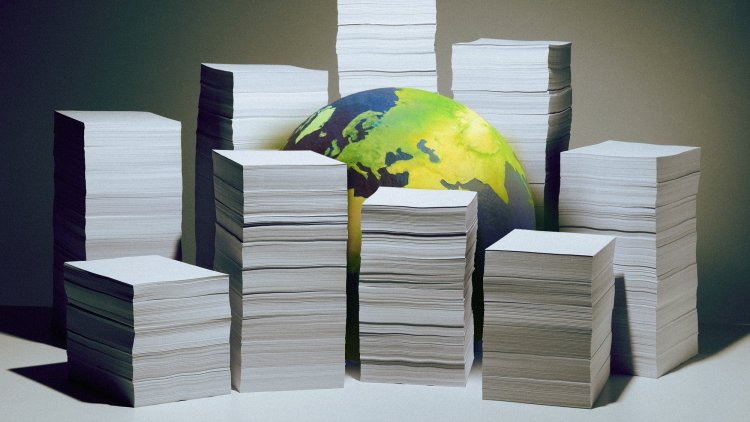American Environmentalism Just Got Shoved Into Legal Purgatory
The Supreme Court’s decision to overrule the longstanding Chevron doctrine could be used to undo environmental progress.

In a 6–3 ruling today, the Supreme Court essentially threw a stick of dynamite at a giant, 40-year-old legal levee. The decision overruled what is known as the Chevron doctrine, a precedent that governed how American laws were administered. In doing so, it likely unleashed a river of litigation, much of which could erode away the country’s climate and environmental ambitions.
The Chevron doctrine held that when Congress passed ambiguously worded statutes, courts would defer to agencies’ interpretations of how to implement them. This was based on a general recognition of the fact that agencies, staffed with subject-matter experts and the ground-level awareness of what was possible to implement and enforce, were the best suited to do that.
But agency expertise has now gone out the window. In his written opinion, Chief Justice John Roberts mocked the very concept of it: “Perhaps most fundamentally, Chevron’s presumption is misguided because agencies have no special competence in resolving statutory ambiguities. Courts do.” The cases before the Court, which were backed by conservative legal organizations dedicated to weakening the federal government’s role in regulating business, had challenged a rule from the National Marine Fisheries Service that requires the herring industry to pay to have observers on their boats, as part of an effort to prevent overfishing. Lower courts had previously found the rule to be a reasonable interpretation of federal law, but the Supreme Court struck it down. Under the same logic, judges, rather than agency scientists, would have the greater authority to interpret the application of regulatory law. (Relatedly, Justice Neil Gorsuch recently mixed up nitrogen dioxide—a pollutant—with nitrous oxide, the laughing gas, in a Supreme Court opinion.)
Until now, deference to the Chevron doctrine has shaped how every area of how law gets carried out. “Congress has relied on it. Agencies have relied on it. Courts have relied on it, and they’ll dare say, indirectly, the American people have relied on it. This is what we’ve governed under for decades, and the Court is throwing it out entirely,” Lisa Heinzerling, a professor at Georgetown University Law Center and an expert in administrative law, told me.
Plenty of lawsuits are likely to be filed thanks to the ruling, though it could be years before the full impact of this decision on environmental protections is clear. President Joe Biden’s landmark climate legislation, the Inflation Reduction Act, was ready for this. Michael Gerrard, the founder and director of the Sabin Center for Climate Change Law at Columbia University, told me it was written with the kind of specificity that would not be as vulnerable to this ruling. Yet a host of other crucial agency actions are more vulnerable, particularly in cases where the EPA is extending or interpreting older statutes to address modern environmental problems.
For example, the EPA uses the Clean Air Act—a broadly written law from the 1970s—to implement all kinds of climate- and health-related measures. The court’s ruling gives more legal running room to challenge those measures, and limits to greenhouse-gas emissions are likely to be one target. The EPA uses several parts of the Clean Air Act to curb emissions, and some are less specific than others, and so more vulnerable to the fall of the Chevron doctrine. Some of the routes the EPA has recently used to regulate the forever-chemicals PFAS may be on shakier ground now too, because they rely on an interpretation of the 1976 Toxic Substances Control Act, rather than on a specific law requiring PFAS to be regulated.
Many legal watchers have anticipated Chevron’s fall, and the EPA has been preparing for it well before today. The agency “has been crafting its legal explanations, as far as I can tell, to try to live in a world without Chevron,” Heinzling said. Still, American environmentalism is entering what is likely to be a long stay in legal purgatory, where rules that held yesterday may not tomorrow, and many arguments about arcane details of regulatory law lie ahead.
[Read: The Supreme Court won’t stop dismantling the government’s power]
Technically, the Chevron doctrine worked in both directions; deference to agencies doesn’t always mean more progressive environmental rulings. And Chevron’s fall could open up avenues for environmentalists to push their vision of environmental law in court, by challenging agencies that aren’t acting aggressively enough, as the original Chevron case did.
But based on the overall flavor of the Court’s other decisions of late, the fruits of this reversal seem unlikely to be handed out evenly. “The court is on a kind of demolition project against the government,” Hertzlinger said. “It’s restructuring it, it’s rejecting long- standing principles of statutory interpretation, it’s tightening down the hatches on agencies’ explanations. It is in a very aggressive mood when it comes to government..” Both Heinzling and Gerrard expect today’s decision to overrule Chevron to be chiefly used to undo or stymie environmental progress.
Congress could subvert the problems that this ruling poses by writing more specific laws, leaving less room for agency interpretation. In 1984, the Democratically controlled House under President Ronald Reagan wrote a meticulously detailed amendment to a law about the treatment of hazardous waste because, in Gerrard’s telling, it didn’t trust Reagan’s EPA to handle the matter sufficiently. But the hope is dim for something like that working out now. And if Donald Trump is reelected, the country can expect no ambitious environmental laws until at least 2029, and some of the ones already in place to be weakened or repealed.
“Robust environmental rule-making would have to wait,” Gerrard said. As climate change accelerates at a dangerous pace, neither the Earth nor anyone living here has time for that.
What's Your Reaction?




















